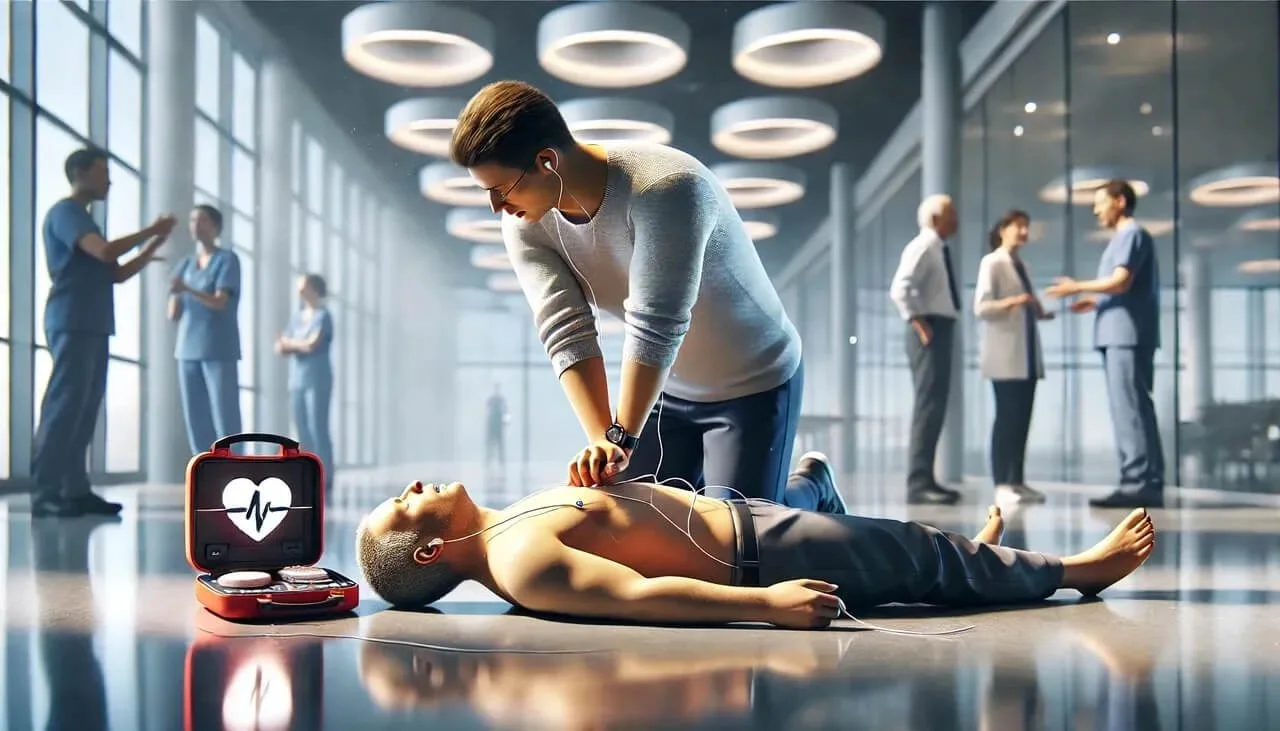CPR and defib AED basics
stylised image of person doing CPR with AED at work
Why We Do CPR the Way We Do
When a person’s heart stops beating, every second counts. CPR (Cardiopulmonary Resuscitation) is a life-saving technique designed to keep blood and oxygen circulating to vital organs until professional help arrives. At www.gungahlia.com.au, we believe in equipping everyone with the skills to save a life. Here’s why we perform CPR the way we do:
💓 100-120 Chest Compressions Per Minute
This rhythm mimics the natural heartbeat and ensures blood continues to flow to the brain and heart. Think of the beat of "Stayin' Alive" by the Bee Gees or "Baby Shark" as a guide!
👐 Hand Placement Matters
Proper hand placement is key. Place the heel of one hand on the centre of the chest, on the lower half of the sternum, and interlock your fingers. This focus ensures that compressions are delivered effectively to pump the heart.
💨 The Advantage of Rescue Breaths
While compressions are critical, rescue breaths help deliver oxygen to the lungs, boosting the chances of survival. A 30:2 ratio (30 compressions followed by 2 breaths) strikes the right balance between maintaining blood flow and replenishing oxygen.
Knowing how to perform CPR can mean the difference between life and death. Visit www.gungahlia.com.au to learn more about the science and techniques behind CPR. Let’s work together to create safer communities, one heartbeat at a time.
CPR vs. AED: The Life-Saving Difference
When it comes to cardiac arrest, immediate action is crucial. While CPR can significantly increase a person's chances of survival, adding an Automated External Defibrillator (AED) dramatically improves those odds. Let’s examine the numbers to understand why AEDs are game-changers in emergency response.
The Power of CPR Alone
CPR is a cornerstone of emergency care, helping to maintain blood flow and oxygen delivery to vital organs. Statistics show that:
Performing CPR immediately after a cardiac arrest can double or triple survival rates compared to no intervention.
The survival rate for cardiac arrest victims who receive CPR but no defibrillation is approximately 9% to 12%.
While CPR buys precious time, it cannot restart a stopped heart. That’s where an AED comes in.
AED + CPR: A Winning Combination
Using an AED alongside CPR significantly increases survival rates. AEDs deliver a controlled shock to the heart, restoring a regular rhythm in cases of ventricular fibrillation or pulseless ventricular tachycardia. Consider these statistics:
Survival rates jump to over 50%-70% when an AED is used within the first 3-5 minutes of cardiac arrest.
For every minute without defibrillation, the chance of survival decreases by 7%-10%, even with CPR.
In communities with widespread access to AEDs, the overall survival rate from sudden cardiac arrest is approximately 38%, compared to less than 10% in areas without AEDs.
Why AEDs Matter
Ease of Use: Modern AEDs are designed for anyone, with clear voice prompts guiding rescuers step-by-step.
Rapid Defibrillation: Delivering a shock quickly is the most effective way to restart the heart and save a life.
Portability: AEDs are increasingly available in public places, workplaces, and homes, making it easier to act fast.
Take Action
CPR is vital, but an AED can be the ultimate difference-maker. Together, they provide the best chance of survival during a cardiac emergency.
At Gungahlia First Aid, we’re passionate about educating the community on life-saving skills. Visit www.gungahlia.com.au to learn about our CPR and AED training courses. Let’s equip ourselves to save lives and build a safer world.
#CPRSavesLives #AEDTraining #FirstAidMatters
#CPRSavesLives #FirstAidMatters #GungahlinFirstAid

